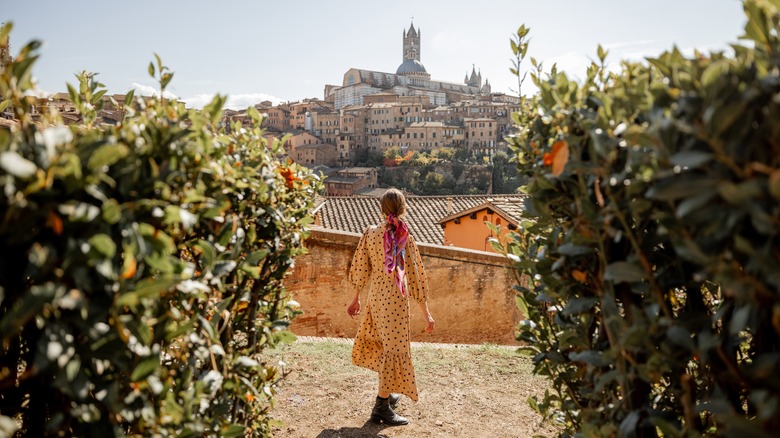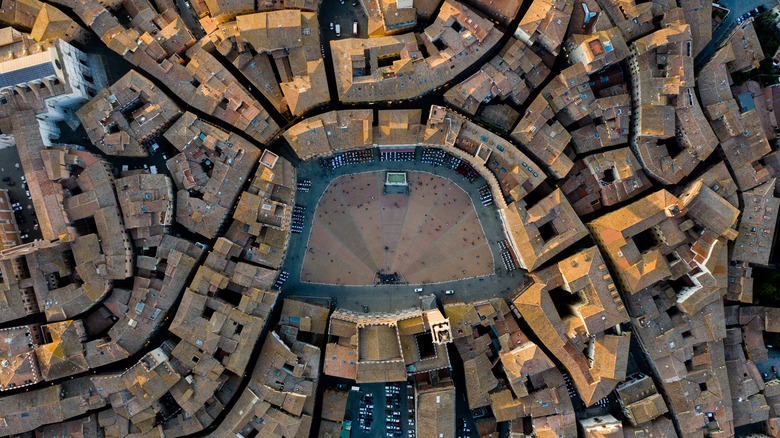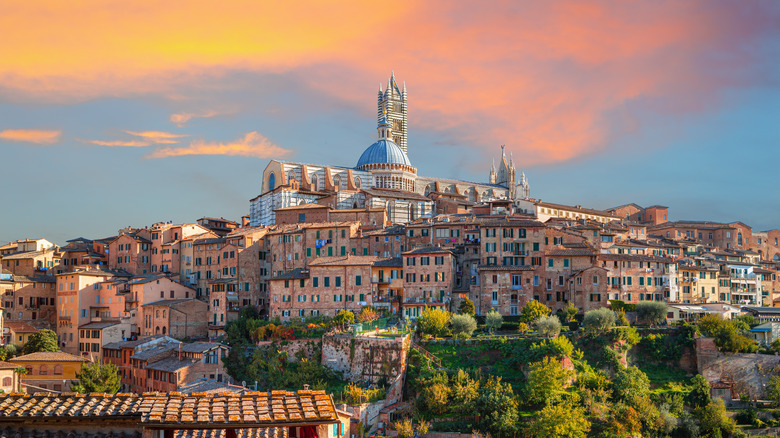The Beautiful Destination With Italy's Best Medieval City Experience, Per Rick Steves
Want to relax and bask in the tranquility of an Italian hillside? How about taking it one step further and enjoying a uniquely Italian historical experience as well? Look no further than Siena, a city atop three hills crowned Italy's best medieval city experience by Rick Steves, a European travel expert. Siena is one of the must-visit spots in Tuscany and the capital of Siena Province, its namesake. Its origins date back to around 900 B.C. when the Etruscans were the Western Mediterranean's first "superpower." Two millennia later, Siena reached a golden age under the Lombard kings in the 12th century. During this period, the city became an important commercial and banking center, competing with the prosperity of its historical rival, Florence, located just 30 miles north.
This territorial conflict, in combination with the effects of the Black Death, the pope's economic sanctions, and political instability, further contributed to its slow decline around the 16th century. The second test Siena faced was during World War II when the French overtook it without resistance. This allowed Siena to avoid destruction and, fortunately, remain as the medieval-looking town it once was. As a result, the entire city has become a UNESCO World Heritage Site and is claimed as "the embodiment of a medieval city" with its 15th-century street plan, gothic architecture, and original functions of areas still used today. So much of Siena remains authentic to its medieval past, giving visitors a genuine, Rick Steves-approved medieval experience in Europe.
The best of medieval Siena
Like all great medieval cities, the 420-acre Siena is fortified by a defensive wall spanning over 4 miles. It's this wall you'll see upon first entering, with 12 remaining gates beautifully preserved. This includes notable entrances like Porta Giustizia, which was once a path to execution for prisoners, Porta a Ovile, one of the most well-preserved with decorations of a 14th-century fresco of the "Virgin and Child," and Porta Camollia, where anybody from Florence would have arrived through. Once you're in, the only way back is "in time." Behold the medieval city of Siena: marvel at its distinctive Gothic style, explore its narrow hill streets, and touch the chipped stone marked by those who came before you.
You don't need to fear getting lost because all roads lead to the iconic shell-shaped Piazza del Campo, which Rick Steves considers the best square in Italy. Within it, you'll find the symbol of Siena, the Torre del Mangia. This 285-foot bell tower was built at the pinnacle of Siena's influence between 1338 and 1348, becoming Italy's third tallest historical tower. Within the square is also the grand gothic-style Banca Monte dei Paschi di Siena, which happens to be one of the oldest banks in the world. As with any great Italian city, there must be a cathedral, and in the Piazza del Duomo stands just that. The 12th-century Siena Cathedral is one of Italy's most breathtaking feats of Romanesque-Gothic architecture and is a must-see.
Tips for your visit to Siena
There are a few tips you need to know before traveling to the old city of Siena. The first tip we'll leave to Rick Steves, as he puts it best: "For those who dream of a Fiat-free Italy, Siena is a haven. Pedestrians rule in the old center of town, as the only drivers allowed are residents and cabbies." How relieving it is for a visitor to be able to explore freely without worrying about traffic or the sounds of loud automobiles. This leads Rick Steves to his second most important tip: Why spend only a day visiting a city you can only walk in? Live like a local and stay a while. There are some gorgeous historical hotels in Italy and several family-run inns in the old center. Siena has plenty to offer; two or three days will do it justice.
More experiences include the Palazzo Pubblico, a culturally important Sienese museum housing several works of art, including Ambrogio Lorenzetti's 14th-century fresco "The Allegory of Good and Bad Government." It covers three walls and is considered one of the most remarkable artistic depictions of life and ideology in a medieval city. Afterward, why not top it off with the best real-life view of the medieval city itself? Climb 400 steps to the top of Torre del Mangia and see Siena from above. Rick Steves recommends being out and about in the evening after all the tour groups are gone — climb up at sunset (last admission is at 6:15 p.m.) and soak everything in.


